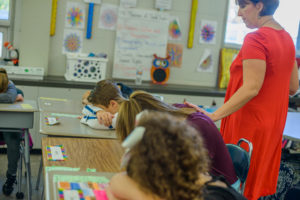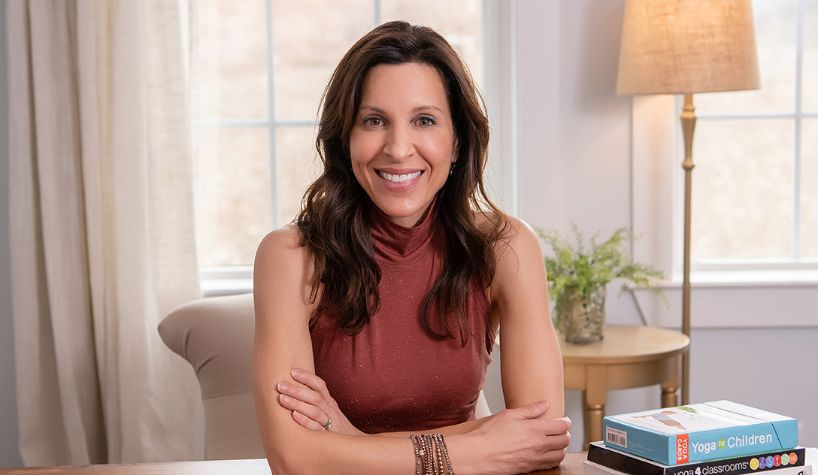
|
Check out our brand new product-- Mini Yoga 4 Classrooms Activity Cards! For mindful moments on-the-go!
|

During a dark period of depression and anorexia during my college years, yoga and other mindful practices were presented as recreation therapy during my stay an in-patient treatment facility. I didn’t fully appreciate it then, but the seeds were planted. Years later, as a much healthier, newly married marketing executive, I rediscovered yoga and began to wonder if having these tools earlier in life may have made a difference. Could mindfulness support mental health prevention by helping to strengthen emotional resilience, particularly for children and youth affected by trauma and adverse life circumstances? At the time I didn’t know the hows and whys, but I knew from my own experience that mindfulness could indeed help to build what I refer to now as a “toolbox for resiliency.”
Years later, as a new mother, I noticed that when my then toddlers would join my morning practice, it was not only fun and natural for them, but seemed to improve their focus and mood as it promoted bonding and connection between us. I went on to search my local area for children and/or family yoga programs and came up empty-handed. So, I attended the first of many trainings in 2003 with the simple intention of sharing what I learned with my own children. However, I had to teach a community class for certification. From the very first day, I knew I had found my calling. Before long, I was teaching up to 15 classes per week in studios, schools, and childcare centers around the Seacoast of southern Maine and New Hampshire. I was so inspired by the anecdotal evidence of benefit, I founded ChildLight Yoga and Yoga 4 Classrooms in the years that followed so that I could have a platform for making what I was sharing more accessible to more children and the adults who serve and support them.
There is an incredible number of benefits. It would take a book to list them all as related to physical, social, emotional, and cognitive development and support (our Supporting Research page is a good place to start). However, I really feel emotional resilience is the most profound benefit of all. We can cultivate it through simple, accessible, consistent yoga and mindfulness practices which provide opportunities for building self-awareness, the foundation of social and emotional development, and student success, in the short and long term.
I’m inspired by the growing amount of evidence coming out in support of yoga and mindfulness for children in and out of schools, my colleagues and their amazing work and contributions to the field, my students, the educators, and school communities I’m fortunate to work with, my team, but most of all it’s my own children, now young adults, who have inspired me most.
At six years old, my son was diagnosed with Sensory Integration Disorder, ADD, and anxiety. At one point, I was told by a psychologist (having met Jack for less than 5 minutes) that not treating my son with anti-anxiety and ADHD medication “would be like withholding insulin from a diabetic,” and that there was a high likelihood he would end up on drugs and in all kinds of trouble as he got older.
Though there are children who clearly need and can benefit from medication, my gut told me otherwise for Jack. With my help and the support of a few amazing teachers who saw his gifts as clearly as I did, he was able to learn tools for self-regulation and slowly build his own emotional resilience, more so over time. Mind you, Jack didn’t buy into the idea of “yoga” by name. But, he quickly learned that Ocean Breath (perhaps with a Breathing Buddy on his belly) helped him fall asleep easier, and Waterfall followed by Rag Doll Pose allowed him to release pent-up energy and big emotions so that he could respond versus react in a challenging situation. Before long, he was sharing his strategies with others he noticed struggling …including me!
Skip ahead 12 years. Just yesterday (9/7/21), Jack headed off to basic training in preparation to serve in the Air National Guard. He’ll return at Christmastime and go on to serve as an Airman part-time while earning a business degree at UNH. He’s a charismatic, funny (hilarious, actually), resourceful, natural-born leader, growth-minded student and worker, and a compassionate friend to all. He’s also resilient, well-equipped to deal with the many challenges, falls, and scrapes that he will surely be faced with along the way whether that be at bootcamp or later throughout his adulthood.
This is what we want for ALL children. It’s why we are educators.
Oh, that’s a tough question, but there are a few things I find especially rewarding right now:
1) Watching the mindfulness movement grow. When I first started sharing mindful practices with children in 2003, no one knew what the heck I was talking about, so I just stopped talking about it, put my head down, and did my thing. I learned to let go of perceptions (or rather, misperceptions), educate without attachment and forge ahead with the reward being the tremendously positive impact it was having in the lives of my students (and my own, btw!). Now, yoga and mindfulness, and specifically for children, is everywhere and getting a good deal of attention, and rightly so. Seeing news clips and articles published, new programs launched, new books written, research published…it’s so validating and makes it incredibly rewarding to be on this path.
2) When I see the inspired eyes of educators and hear the ‘aha’ moments of reflections in our Yoga and Mindfulness in the Classroom trainings, or when I read the reviews of the Yoga 4 Classrooms Activity Cards, or receive an email of gratitude from a school administrator, educator, or parent…I know I have planted a seed that just might sprout into making a tangible difference in their lives and the lives of their students.
3) Brainstorming ways to make these impactful practices more accessible, such as launching the the digital English and digital Spanish version of Yoga 4 Classrooms Cards during the pandemic, creating training and curricula, videos, and finding other ways to support schools in a way that is cost-effective and sustainable, provides me with challenge and purpose. Though I appreciate the experiences I gained in my previous careers, this is not necessarily something I experienced as a marketing director of golf courses or as a technology advertising executive. It’s all so rewarding.
4) I am honored to work with bright, committed, and passionate team members, educators, school administrators, and colleagues in the field. I continue to learn so much from all of them each and every day.
I envision a world in which pausing to take a mindful moment becomes as much a cultural norm as stopping to look both ways before crossing the street; a world in which having a mindfulness mindset is encouraged and respected; where self-awareness is modeled and taught; and humankind is thoughtful, compassionate and responsive versus reactive. The by-products of this vision are improved personal well-being and success (social, emotional, mental, physical, academic, career…) and ultimately, a more compassionate, inclusive, and equitable world. It can start with creating mindful school communities.
With increasing recognition of the importance of mental health and prevention, a desire to support all students in being successful, and concerns about teacher well-being, I’m confident we’re going to see yoga and mindfulness integrated as an integral part of SEL, whole child education, school wellness, and equity and inclusion initiatives at every school, schoolwide, as mandated by educational policy and standards. This is happening already and it will only continue to grow as support increases in light of a growing body of supporting research and following that, policy and financial support.
Learn more about Lisa and Yoga 4 Classrooms.
This Q&A has been updated and reprinted with permission of The National Kids’ Yoga Conference where it was first featured leading up to the annual conference at which Lisa was a keynote speaker.
| Cookie | Duration | Description |
|---|---|---|
| cookielawinfo-checkbox-analytics | 11 months | This cookie is set by GDPR Cookie Consent plugin. The cookie is used to store the user consent for the cookies in the category "Analytics". |
| cookielawinfo-checkbox-functional | 11 months | The cookie is set by GDPR cookie consent to record the user consent for the cookies in the category "Functional". |
| cookielawinfo-checkbox-necessary | 11 months | This cookie is set by GDPR Cookie Consent plugin. The cookies is used to store the user consent for the cookies in the category "Necessary". |
| cookielawinfo-checkbox-others | 11 months | This cookie is set by GDPR Cookie Consent plugin. The cookie is used to store the user consent for the cookies in the category "Other. |
| cookielawinfo-checkbox-performance | 11 months | This cookie is set by GDPR Cookie Consent plugin. The cookie is used to store the user consent for the cookies in the category "Performance". |
| viewed_cookie_policy | 11 months | The cookie is set by the GDPR Cookie Consent plugin and is used to store whether or not user has consented to the use of cookies. It does not store any personal data. |